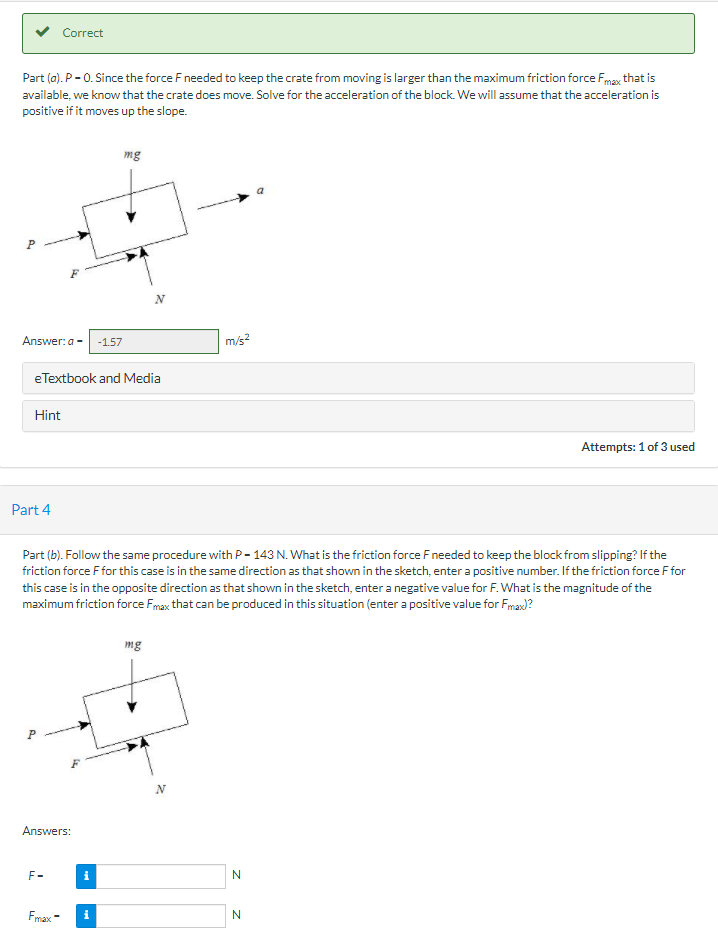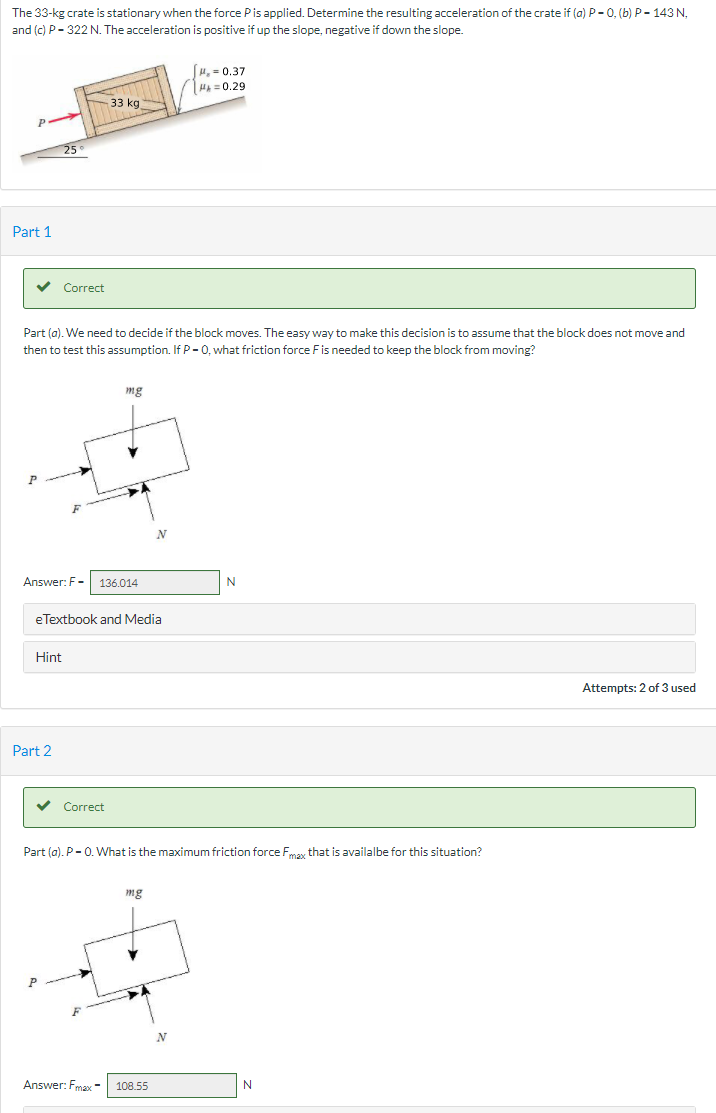The 33-kg crate is stationary when the force Pis applied. Determine the resulting acceleration of the crate if (a) P-0, (b) P- 143 N. and (c) P- 322 N. The acceleration is positive if up the slope, negative if down the slope. [H, = 0.37 H = 0.29 33 kg Part 1 Correct Part (a). We need to decide if the block moves. The easy way to make this decision is to assume that the block does not move and then to test this assumption. If P-0, what friction force Fis needed to keep the block from moving? mg Answer: F- 136.014 N eTextbook and Media Hint Attempts: 2 of 3 used Part 2 Correct Part (a). P-0. What is the maximum friction force Fmay that is availalbe for this situation? mg Answer: Fmax- 108.55 N
The 33-kg crate is stationary when the force Pis applied. Determine the resulting acceleration of the crate if (a) P-0, (b) P- 143 N. and (c) P- 322 N. The acceleration is positive if up the slope, negative if down the slope. [H, = 0.37 H = 0.29 33 kg Part 1 Correct Part (a). We need to decide if the block moves. The easy way to make this decision is to assume that the block does not move and then to test this assumption. If P-0, what friction force Fis needed to keep the block from moving? mg Answer: F- 136.014 N eTextbook and Media Hint Attempts: 2 of 3 used Part 2 Correct Part (a). P-0. What is the maximum friction force Fmay that is availalbe for this situation? mg Answer: Fmax- 108.55 N
Elements Of Electromagnetics
7th Edition
ISBN:9780190698614
Author:Sadiku, Matthew N. O.
Publisher:Sadiku, Matthew N. O.
ChapterMA: Math Assessment
Section: Chapter Questions
Problem 1.1MA
Related questions
Question
100%

Transcribed Image Text:v Correct
Part (a). P - 0. Since the force F needed to keep the crate from moving is larger than the maximum friction force Fmax that is
available, we know that the crate does move. Solve for the acceleration of the block. We will assume that the acceleration is
positive if it moves up the slope.
mg
N
Answer:a -
-1.57
m/s?
eTextbook and Media
Hint
Attempts: 1 of 3 used
Part 4
Part (b). Follow the same procedure with P- 143 N. What is the friction force Fneeded to keep the block from slipping? If the
friction force F for this case is in the same direction as that shown in the sketch, enter a positive number. If the friction force F for
this case is in the opposite direction as that shown in the sketch, enter a negative value for F. What is the magnitude of the
maximum friction force Fmax that can be produced in this situation (enter a positive value for Fmax)?
mg
Answers:
F-
i
Fmax -
i

Transcribed Image Text:The 33-kg crate is stationary when the force Pis applied. Determine the resulting acceleration of the crate if (a) P- 0, (b) P- 143 N.
and (c) P- 322 N. The acceleration is positive if up the slope, negative if down the slope.
[H, = 0.37
H = 0.29
33 kg
25°
Part 1
v Correct
Part (a). We need to decide if the block moves. The easy way to make this decision is to assume that the block does not move and
then to test this assumption. If P- 0, what friction force Fis needed to keep the block from moving?
mg
Answer: F-
136.014
N
eTextbook and Media
Hint
Attempts: 2 of 3 used
Part 2
v Correct
Part (a). P- 0. What is the maximum friction force Fmey that is availalbe for this situation?
mg
N
Answer: Fmax -
108.55
N
Expert Solution
This question has been solved!
Explore an expertly crafted, step-by-step solution for a thorough understanding of key concepts.
Step by step
Solved in 3 steps with 3 images

Knowledge Booster
Learn more about
Need a deep-dive on the concept behind this application? Look no further. Learn more about this topic, mechanical-engineering and related others by exploring similar questions and additional content below.Recommended textbooks for you

Elements Of Electromagnetics
Mechanical Engineering
ISBN:
9780190698614
Author:
Sadiku, Matthew N. O.
Publisher:
Oxford University Press

Mechanics of Materials (10th Edition)
Mechanical Engineering
ISBN:
9780134319650
Author:
Russell C. Hibbeler
Publisher:
PEARSON

Thermodynamics: An Engineering Approach
Mechanical Engineering
ISBN:
9781259822674
Author:
Yunus A. Cengel Dr., Michael A. Boles
Publisher:
McGraw-Hill Education

Elements Of Electromagnetics
Mechanical Engineering
ISBN:
9780190698614
Author:
Sadiku, Matthew N. O.
Publisher:
Oxford University Press

Mechanics of Materials (10th Edition)
Mechanical Engineering
ISBN:
9780134319650
Author:
Russell C. Hibbeler
Publisher:
PEARSON

Thermodynamics: An Engineering Approach
Mechanical Engineering
ISBN:
9781259822674
Author:
Yunus A. Cengel Dr., Michael A. Boles
Publisher:
McGraw-Hill Education

Control Systems Engineering
Mechanical Engineering
ISBN:
9781118170519
Author:
Norman S. Nise
Publisher:
WILEY

Mechanics of Materials (MindTap Course List)
Mechanical Engineering
ISBN:
9781337093347
Author:
Barry J. Goodno, James M. Gere
Publisher:
Cengage Learning

Engineering Mechanics: Statics
Mechanical Engineering
ISBN:
9781118807330
Author:
James L. Meriam, L. G. Kraige, J. N. Bolton
Publisher:
WILEY